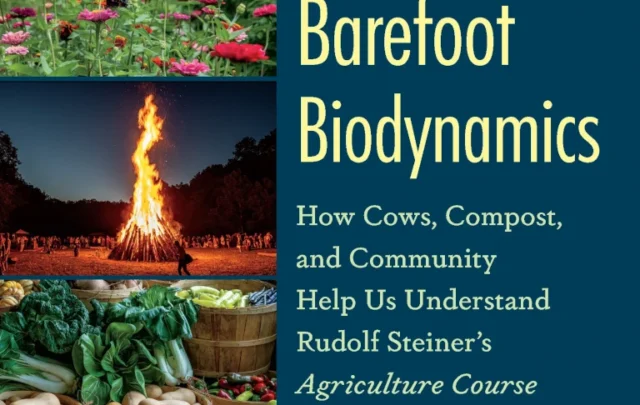When I teach permaculture, and now having done more than 50 full design courses, I try to de-emphasize gardening. I do that because I know that most other Permaculture teachers do precisely the opposite; they begin with drawing a chicken and then make mandala gardens and herb spirals.
I don’t usually do that because to me Permaculture is much more. It is a regenerative design science. It teaches you to think ecosystemically: no waste; cyclical; nourishing body and soul; steady state. It applies to every aspect of your life, and of civilization; from how we brush our teeth to how we build our cities and exchange value for value.
But Permaculture is also about looking ahead, over the fence, up to the sky, into the forest, and observing the grander patterns. Anyone who takes that kind of moment these days will be bound to notice phenological signs and portents, the uptick in unusual weather events, a spreading refugee crisis, and some really nasty resource wars appealing to our ethnic tribali
 |
|
There are seven popular food crops in this picture
|
“The switch from growth to decline in oil production will thus almost certainly create economic and political tension.”— Colin Campbell and Jean Laherrére, Scientific American (1998)
These times have been long predicted, from Malthus’ and Arhennius’ calculations of population and carbon dioxide, to Limits to Growth, The Population Bomb, and now decades of reports from the UN Intergovernmental Panel on Climate Change. All of those, and more, are known knowns.
Kerry Emanuel told us about the hurricanes and superstorms in 1987. I predicted the spread of mosquitoes, ticks, and viruses in 1989. In that same decade James Lovelock, Tim Lenton, Johan Shellnhuber and others were warning that after diverging 2 degrees Celsius from the pre-industrial maxima the carrying capacity of global agriculture would no longer support more than 2 billion people, and possibly fewer than 1 billion.
Healthy humans cannot be decoupled from net photosynthetic productivity and that cannot be decoupled from favorable growing conditions; ie: the Holocene epoch of mild and predictable sunlight and rainfall over vast areas of favorable soil.
Last year, a distinguished group of scientists issued this warning:
…[B]iomass plantations with subsequent carbon immobilization are likely unable to “repair” insufficient emission reduction policies without compromising food production and biosphere functioning due to its space‐consuming properties. Second, the requirements for a strong mitigation scenario staying below the 2°C target would require a combination of high irrigation water input and development of highly effective carbon process chains. Although we find that this strategy of sequestering carbon is not a viable alternative to aggressive emission reductions, it could still support mitigation efforts if sustainably managed.
This leaves us with a rather clear, but hardly comforting overall conclusion: Holding the 2°C line seems only feasible if two sets of climate action work hand in hand. On the one hand, greenhouse gas emissions need to be reduced as early and as effectively as possible. In fact, an even more aggressive strategy than reflected by the [IPCC] RCP2.6 scenario should be pursued, aiming at the “induced implosion” of most fossil fuel‐driven business cases in the next couple of decades. On the other hand, tCDR [carbon dioxide removal] can significantly contribute as a “supporting actor” of the mitigation protagonist, if it gets started and deployed immediately. This means that the biological extraction of atmospheric CO2 as well as the suppression of CO2 release from biological systems must draw upon all possible measures — whether they are optimal or not, whether they are high‐ or low‐tech. We therefore suggest fully exploring the pertinent options available now, which include reforestation of degraded land and the protection of degraded forests to allow them to recover naturally and increase their carbon storage, e.g., within the Bonn Challenge initiative or the New York Declaration on Forests. Further options range from up‐scaled agroforestry approaches to the application of biochar and various no‐tillage practices for food production on appropriate soils. Also, it becomes overwhelmingly evident that humanity cannot anymore afford to waste up to 50% of its agricultural harvest along various consumption chains or to go on operating ineffective irrigation systems.
All of those techniques —reforestation of degraded land, up‐scaled agroforestry, biochar, organic no-till, eliminating waste, and low-tech, broad dissemination — are the meat and potatoes of Permaculture.
In 2008, James Lovelock wrote:
Whatever we do is likely to lead to death on a scale that makes all previous wars, famines and disasters small. To continue business as usual will probably kill most of us during the century. Is there any reason to believe that fully implementing Bali, with sustainable development and the full use of renewable energy, would kill less? We have to consider seriously that, as with nineteenth century medicine, the best option is often kind words and pain killers but otherwise do nothing and let Nature take its course.
Had we heeded Malthus’s warning and kept the human population to less than one billion, we would not now be facing a torrid future. Whether or not we go for Bali or use geoengineering, the planet is likely, massively and cruelly, to cull us, in the same merciless way that we have eliminated so many species by changing their environment into one where survival is difficult.
Permaculture is not willing to go gentle into that good night. And this is why food is so core to its pedagogy. As a movement it is training as many people as possible, from white-gloved suburbanites to war-ravaged refugees, how to garden. It is showing, through gardening, not-merely self-sufficiency and survival in daunting times, but regeneration of soils, recapture of carbon, and ingenious means for restoring the natural balance that ultimately will be the way we end the crises we are now committed to experiencing.
And with any luck, we’ll also get to eat.





